Computer Workstations eTool
Computer Workstations » Workstation Environment

Appropriately placing lighting and selecting the right level of illumination can enhance your ability to see monitor images. For example, if lighting is excessive or causes glare on the monitor screen, you may develop eyestrain or headaches, and may have to work in awkward postures to view the screen. Ventilation and humidity levels in office work environments may affect user comfort and productivity.
Environment Quick Tips
- Arrange your office to minimize glare from overhead lights, desk lamps, and windows.
- Maintain appropriate air circulation.
- Avoid sitting directly under air conditioning vents that "dump" air right on top of you.
Potential Hazard
Bright lights shining on the display screen "wash out" images, making it difficult to clearly see your work. Straining to view objects on the screen can lead to eye fatigue.
Possible Solutions
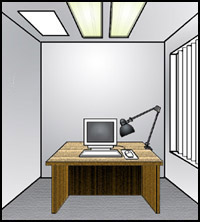
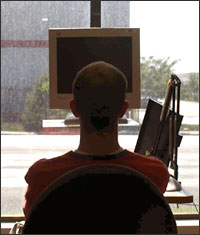
- Place rows of lights parallel to your line of sight (Figure 1).
- Provide light diffusers so that desk tasks (writing, reading papers) can be performed while limiting direct brightness on the computer screen.
- Remove the middle bulbs of 4-bulb fluorescent light fixtures to reduce the brightness of the light to levels more compatible with computer tasks if diffusers or alternative light sources are not available. NOTE: a standard florescent light fixture on a nine-foot ceiling with four, 40-watt bulbs will produce approximately 50 foot-candles of light at the desktop level.
- Provide supplemental task/desk lighting to adequately illuminate writing and reading tasks while limiting brightness around monitors.
- Generally, for paper tasks and offices with CRT displays, office lighting should range between 20 to 50 foot-candles. If LCD monitors are in use, higher levels of light are usually needed for the same viewing tasks (up to 73 foot-candles).
Potential Hazard
Bright light sources behind the display screen can create contrast problems, making it difficult to clearly see your work (Figure 2).
Possible Solutions
- Use blinds or drapes on windows to eliminate bright light. Blinds and furniture placement should be adjusted to allow light into the room, but not directly into your field of view (Figure 1). NOTE: vertical blinds work best for East/West facing windows and horizontal blinds for North/South facing windows.
- Use indirect or shielded lighting where possible and avoid intense or uneven lighting in your field of vision. Ensure that lamps have glare shields or shades to direct light away from your line of sight.
- Reorient the workstation so bright lights from open windows are at right angles with the computer screen (Figure 1).
Potential Hazard
High contrast between light and dark areas of the computer screen, horizontal work surface, and surrounding areas can cause eye fatigue and headaches.
Possible Solutions
- For computer work, use well-distributed diffuse light. The advantage of diffuse lighting is that:
- There are fewer hot spots (or glare surfaces) in the visual field.
- The contrasts created by the shape of objects tend to be softer.
- Use light, matte colors and finishes on walls and ceilings to better reflect indirect lighting and reduce dark shadows and contrast.
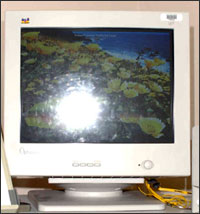
Potential Hazard
Direct light sources (for example, windows, overhead lights) that cause reflected light to show up on the monitor (Figure 3) make images more difficult to see, resulting in eye strain and fatigue.
Possible Solutions
- Place the face of the display screen at right angles to windows and light sources. Position task lighting (for example, a desk lamp) so the light does not reflect on the screen (Figure 1).
- Clean the monitor frequently. A layer of dust can contribute to glare.
- Use blinds or drapes on windows to help reduce glare (Figure 1). NOTE: vertical blinds work best for East/West facing windows and horizontal blinds for North/South facing windows.
- Use glare filters that attach directly to the surface of the monitor to reduce glare (Figure 4). Glare filters, when used, should not significantly decrease screen visibility. Install louvers, or "egg crates", in overhead lights to re-direct lighting.
- Use barriers or light diffusers on fixtures to reduce glare from overhead lighting.
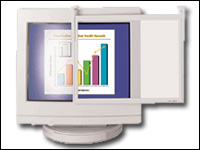
Potential Hazard
Reflected light from polished surfaces, such as a keyboards, may cause annoyance, discomfort, or loss in visual performance and visibility.
Possible Solutions
NOTE: Generally, a large number of low powered lamps rather than a small number of high powered lamps will result in less glare.
- To limit reflection from walls and work surfaces around the screen, paint them with a medium colored, non-reflective paint. Arrange workstations and lighting to avoid reflected glare on the display screen or surrounding surfaces.
- Tilt down the monitor slightly to prevent it from reflecting overhead light.
- Set the computer monitor for dark characters on a light background; they are less affected by reflections than are light characters on a dark background.
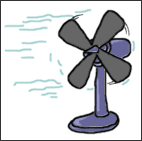
Potential Hazards
- Users may experience discomfort from poorly designed or malfunctioning ventilation systems, for example, air conditioners or heaters that directly "dump" air on users.
- Dry air can dry the eyes (especially if the user wears contact lenses).
- Poor air circulation can result in stuffy or stagnant conditions.
- Temperatures above or below standard comfort levels can affect comfort and productivity.
Possible Solutions
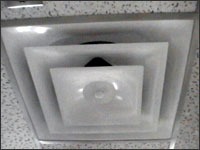
- Do not place desks, chairs, and other office furniture directly under air conditioning vents unless the vents are designed to redirect the air flow away from these areas.
- Use diffusers or blocks to redirect and mix air flows from ventilation systems (Figure 6).
- Keep air flow rates within three and six inches per second (7.5 and 15 centimeters per second). These air flow rates are barely noticeable or not noticeable at all.
- Keep relative humidity of the air between 30% and 60%.
- The recommended ambient indoor temperatures range between 68° and 74° F (20° and 23.5° C) during heating season and between 73° and 78° F (23° and 26° C) during the cooling season.
Potential Hazard
Exposure to chemicals, volatile organic compounds (VOCs), ozone, and particles from computers and their peripherals (for example, laser printers) may cause discomfort or health problems.
Possible Solutions
- Enquire about the potential for a computer or its components to emit pollutants. Those that do should be placed in well-ventilated areas.
- Maintain proper ventilation to ensure that there is an adequate supply of fresh air.
- Allow new equipment to "air out" in a well-ventilated area prior to installing.

